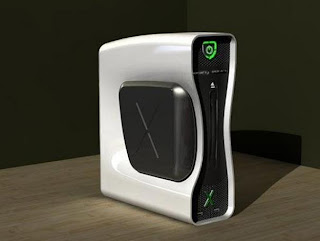While Sony already admitted to be thinking about the PlayStation 4 and Nintendo are no doubt developing a Wii 2… In an interview with the head of Microsoft’s Interactive Entertainment Business division, Peter Moore, EGM magazine asked him when their next video game console would come out, and also asked if they’d drop support for the Xbox 360 like they did with the original Xbox. He said that they were going to support it “as long as it sold.” Possibly because they saw the Xbox sell well into 2007 despite not producing the console after October 2005.
He said the production team from the Xbox 360 is working on the next Xbox 720 [our pet name], and their looking into what kind of CPUs will be available on the market in 2011-2012. That would put the Xbox 360 at a lifespan of 6 or 7 years, a far cry from the Xbox’s 4 years. After spending $1.26 billion in losses launching the Xbox 360, they’ll want to get the most out of the system by lengthening its lifespan. As the longer you get into the cycle, the more profit you can make due to stopping being a loss leader, analysts always remark.We started thinking about the next generation before we shipped the Xbox 360. It doesn’t start with a date. It starts way upstream with silicon development. From that comes a series of data points. You start making early technology choices. It’s an evolving thing. Stuff doesn’t become concrete until you get inside a window of when you have to ship, more than 18 months or so out.”
In late 2008, The Inquirer newspaper reported on speculation from industry insiders that Intel is trying to get its high-performance, new architecture GPU Larrabee chipset into the next-gen Xbox 720… both of which are codenames…
Their sources claim that: “Intel has offered Microsoft a very sweet deal indeed in exchange for pushing AMD out of the running for Microsoft’s upcoming Xbox 720. Offering everything from chips to chassis, Intel is purportedly wooing the Vole right down to designing its thermals and pimping the Larrabee chipset out to Microsoft to subcontract out as it pleases. Needless to say, this gives the Vole some rather hefty bargaining power, and leaves both AMD and Nvidia quivering in their boots.
[...] in all likelihood, Larrabee version one will barely take off, but with the right console deal, Larabee Two — which should be making its first appearance somewhere around 2010 — could be a big player.”
As you may or may not know, the Xbox 360′s internals consist out of a PowerPC-based CPU from IBM and a GPU designed by ATI. So an Intel deal would definitely change things up, and aside from emulation, hardware backwards compatibility might be out of the picture as a result. Advantages of the Larrabee chipset are shown in this image:
In May 2009 Wedbush Morgan analyst Michael Pachter claimed: “We do not expect the ‘next’ generation to begin before 2013, if at all. We remain convinced that the publishers will resist the introduction of any video game hardware technology that requires a refresh of software, as the publishers have as yet to capitalize on the immense investments made in being competitive in the current cycle.”
In June 2009 TeamXbox.com claimed: “The only thing I’m going to say about everything I heard regarding the next Xbox is that it won’t launch until a certain type of television becomes more widespread because in addition to built-in Natal tech, a key feature of the next Xbox would be full HD stereoscopic 3D visuals similar to 3D movie theatres.”
In October 2009 Fuzilla.com industry sources claimed: AMD / ATI has already won the GPU deal for Microsoft’s next generation Xbox console. They also created the current Xbox 360 Xeon GPU, suggesting compatibility with legacy games. The report also states that the new console won’t be released before 2012, since the current economic recession is preventing an originally planned 2010 release.
In January 2010 David Hufford, senior director of Xbox product management, said in a briefing at the Consumer Electronics Show 2010 in Las Vegas that there’s no need for an Xbox 720 yet. To quote: “I think it’s important to say that the Xbox 360 is the console of the long future for us. There is no need to launch a new console, because we’re able to give this console new life either with software upgrades or hardware upgrades like Project Natal. The Xbox 360 was designed for a long life, and I don’t even know if we’re at the midpoint yet.”
Some pictures of what the Xbox 720 may be:






































